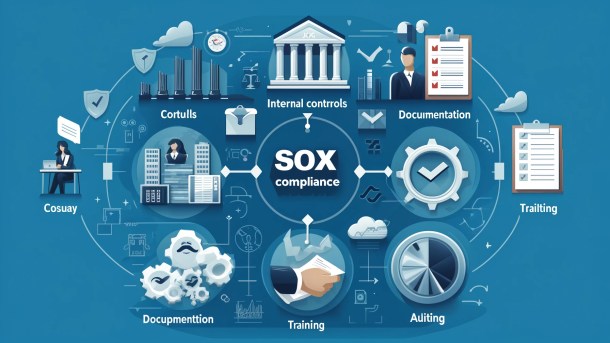The Sarbanes-Oxley Act (SOX) mandates strict reforms to improve financial disclosures and prevent accounting fraud. Ensuring SOX compliance is critical for public companies, but the process can be complex and fraught with challenges. This guide will help you navigate SOX compliance by highlighting common pitfalls and offering strategies to avoid them, ensuring your organization meets regulatory requirements effectively.
Understanding SOX Compliance
Overview of SOX
The Sarbanes-Oxley Act of 2002 was enacted in response to major corporate scandals to protect investors by improving the accuracy and reliability of corporate disclosures. SOX compliance involves adhering to strict regulations that govern financial reporting, internal controls, and corporate governance.
Importance of SOX Compliance
SOX compliance is essential for maintaining investor trust, avoiding legal penalties, and ensuring the integrity of financial reporting. Non-compliance can result in severe consequences, including hefty fines, legal actions, and damage to an organization’s reputation.
Common Pitfalls in SOX Compliance
1. Inadequate Documentation
Lack of Comprehensive Documentation
One of the most common pitfalls in SOX compliance is inadequate documentation. Organizations often fail to maintain comprehensive records of their financial processes, internal controls, and compliance activities. Without proper documentation, it is challenging to demonstrate compliance during an audit.
Inconsistent Documentation Practices
Inconsistent documentation practices can lead to gaps and inaccuracies in records. It’s crucial to standardize documentation procedures across the organization to ensure consistency and completeness.
2. Insufficient Internal Controls
Weak Internal Control Systems
Weak internal controls can expose organizations to financial misstatements and fraud. Many companies struggle with designing and implementing effective controls that meet SOX requirements.
Failure to Update Controls
Internal controls must evolve with changing business processes and regulatory requirements. Organizations often neglect to update their controls, leading to outdated and ineffective compliance measures.
3. Poor Risk Assessment
Inadequate Risk Identification
Failing to conduct thorough risk assessments can result in unidentified vulnerabilities and compliance gaps. Organizations must proactively identify and address risks to maintain SOX compliance.
Lack of Continuous Risk Monitoring
SOX compliance is not a one-time effort. Continuous risk monitoring is essential to detect and mitigate emerging threats. Many organizations fall short in maintaining ongoing risk assessment and monitoring practices.
4. Ineffective Communication and Training
Lack of Employee Training
Employees play a crucial role in maintaining SOX compliance, yet many organizations fail to provide adequate training on compliance requirements and internal controls. Without proper training, employees may inadvertently violate SOX regulations.
Poor Communication
Effective communication is vital for ensuring that all stakeholders understand their roles and responsibilities in maintaining SOX compliance. Poor communication can lead to misunderstandings and compliance failures.
5. Inadequate Audit Preparation
Unprepared for External Audits
Organizations often face challenges in preparing for external audits due to inadequate documentation, weak internal controls, and poor communication. Being unprepared can lead to audit findings and potential penalties.
Neglecting Internal Audits
Regular internal audits are essential for identifying and addressing compliance issues before an external audit. Many organizations neglect internal audits, increasing the risk of non-compliance.
Strategies to Avoid SOX Compliance Pitfalls
1. Strengthen Documentation Practices
Standardize Documentation Procedures
Implement standardized documentation procedures across the organization to ensure consistency and completeness. Use templates and checklists to maintain comprehensive records of financial processes, internal controls, and compliance activities.
Regularly Review and Update Documentation
Conduct regular reviews of documentation to ensure it remains accurate and up-to-date. Update records as needed to reflect changes in business processes and regulatory requirements.
2. Enhance Internal Controls
Design Effective Internal Controls
Design and implement robust internal controls that meet SOX requirements. Ensure that controls are tailored to the organization’s specific risks and business processes.
Regularly Test and Update Controls
Regularly test the effectiveness of internal controls and update them as needed. Conduct control assessments and audits to identify weaknesses and implement corrective actions.
3. Improve Risk Assessment and Monitoring
Conduct Comprehensive Risk Assessments
Perform comprehensive risk assessments to identify and address potential vulnerabilities. Use risk assessment frameworks to evaluate the likelihood and impact of risks on financial reporting.
Implement Continuous Risk Monitoring
Establish continuous risk monitoring practices to detect and mitigate emerging threats. Use automated tools and technologies to monitor risks in real-time and respond promptly.
4. Enhance Communication and Training
Provide Regular Training
Provide regular training sessions for employees on SOX compliance requirements, internal controls, and their roles in maintaining compliance. Ensure that training materials are up-to-date and relevant.
Foster Effective Communication
Establish clear communication channels to keep stakeholders informed about SOX compliance efforts and expectations. Encourage open communication and feedback to identify and address compliance issues.
5. Prepare for Audits
Conduct Regular Internal Audits
Conduct regular internal audits to assess compliance with SOX requirements. Use internal audit findings to identify and address compliance issues before an external audit.
Plan and Prepare for External Audits
Develop a comprehensive audit preparation plan to ensure readiness for external audits. Gather and organize documentation, test internal controls, and communicate audit expectations to all stakeholders.
Benefits of Avoiding SOX Compliance Pitfalls
Enhanced Financial Integrity
By avoiding common pitfalls and implementing robust compliance practices, organizations can enhance the integrity of their financial reporting. Accurate and reliable financial disclosures build investor trust and confidence.
Reduced Risk of Penalties
Maintaining SOX compliance helps organizations avoid legal penalties and fines associated with non-compliance. Proactive compliance efforts reduce the risk of regulatory actions and associated costs.
Improved Operational Efficiency
Implementing effective controls, documentation practices, and risk management processes can improve overall operational efficiency. Streamlined processes reduce redundancies and enhance productivity.
Increased Stakeholder Trust
Demonstrating a commitment to SOX compliance enhances trust with stakeholders, including investors, customers, and partners. A strong compliance posture fosters positive relationships and business growth.
Achieving and maintaining SOX compliance requires a proactive approach to avoid common pitfalls. By strengthening documentation practices, enhancing internal controls, improving risk assessment and monitoring, fostering effective communication and training, and preparing thoroughly for audits, organizations can ensure compliance and protect their financial integrity. Implementing these strategies will help your organization navigate the complexities of SOX compliance and build a strong foundation for long-term success.



















